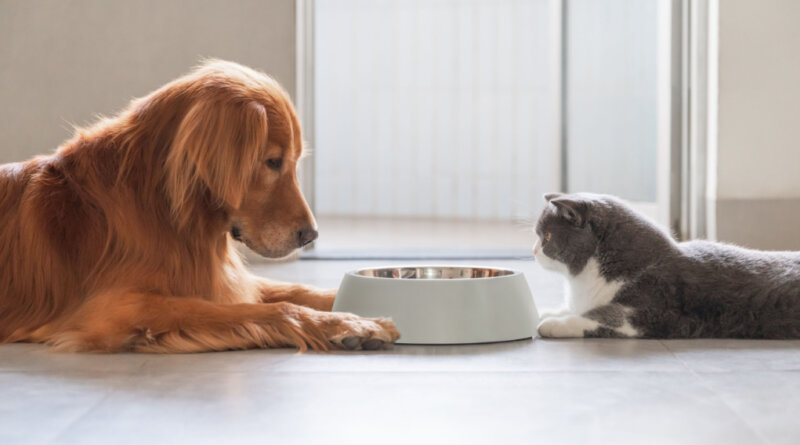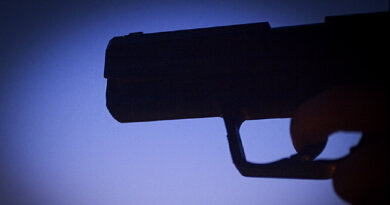Why Is It Harmful? – Top Dog Tips

Dogs eating cat food can bring a few scenarios in mind for fur parents who own both animals.
Well, I’m one.
Since I only have 1 pup (at the moment) and 6 cats, I couldn’t help but entertain this crazy thought in my head sometimes:
“What if my dog ate cat food? Would it be harmful?”
And especially since I allot a bigger budget for cat food, I tend to come up with the idea if I can let my solo pooch join the feline diet club.
Well, a little research prevented me from doing so.
And in this blog, I’ll share why. (You don’t wanna miss this!)
Without further ado, let’s get right into it!
My Dog Ate Cat Food: Why Is it Harmful?
1. Cat Foods Are High in Protein
Proteins are the building blocks of your pet’s health, but too much can be a bad thing, too.
So, if your dog keeps feasting on cat food, it’ll likely develop or experience the following conditions:
Weight gain and Obesity
According to Ashley Gallagher, DVM:
With over 50% of dogs in the U.S. considered overweight or obese, dog owners need to be aware of where those extra calories are hiding.
Fact: Unhealthy weight gain in dogs poses health risks.
You might have been feeding them the wrong diet.
Or… maybe your pooch is secretly munching on your cat’s food.
Why do cat foods cause weight gain in dogs?
Protein is known to be calorie-dense.
And since cat foods contain high amounts of protein, you can just imagine the calorie levels your dog is taking in its system.
When your dog is diagnosed with obesity, it can suffer from a lot of diseases, such as:
Important: If your dog has an underlying medical condition, be sure to seek expert advice for proper diet assessment.
Liver and Kidney Damage
If your dog has liver or kidney problems, too much protein in its system can put unnecessary stress on these organs.
Unhealthy protein levels in the canine diet can also disrupt its nutrient balance, which worsens your dog’s condition.
Without proper intervention, dogs with liver disease can suffer from seizures, coma, or death.
And when this disease worsens, it can lead to a brain condition called hepatic encephalopathy.
Kidney disease, on the other hand, can also pose life-threatening risks to your dogs.
And severe kidney problems can lead to:
Feeding dogs with kidney disease can be tricky. So, be sure to check this with your vet.
RELATED: How to Feed Dogs With Liver Disease
2. Can Cause Pancreatitis
The dangers of protein-rich foods take a toll on your dogs like a domino or boomerang effect.
Pancreatitis (pancreas inflammation), for instance, can develop from underlying conditions, such as:
- Obesity
- Diabetes mellitus
- Low thyroid function
Firstly, protein-rich food can cause obesity in dogs due to its dense calorie component, causing obesity.
Obesity, on the other hand, can also cause diabetes by:
…contributing to insulin resistance and is a risk factor for pancreatitis. — AKC
And dogs eating cat food cannot escape this health warning due to its high protein and fat content.
If your dogs are left feasting on a feline diet for a long time, they may show the following symptoms of pancreatitis:
According to Dr. Rae Sires of Vets Specialists, dogs need “food that is complete and balanced (including all essential vitamins and minerals), low in fat, and easy to digest.”
“Low fat and moderate protein are recommended to meet the dog’s nutritional needs without contributing to excessive pancreas stimulation, which could worsen pancreatitis.”
3. Can Cause Digestive Problems
“Digestion is critical not only for providing nutrients but also for maintaining the proper balance of fluid and electrolytes (salts) in the body.” — Stanley I. Rubin , DVM, MS, DACVIM
Apart from infectious diseases, digestive problems can occur in dogs by overeating or eating food outside their main diet.
And especially for Fidos with sensitive tummies, eating cat food can upset their gut.
4. Triggers hyperlipidemia in your dogs
Cat foods are also high in fat.
Without regulation, both dogs and cats can suffer from hyperlipidemia or too many fat molecules (lipids) in the bloodstream.
Note: Fats are not bad for your dogs at all.
In fact, the 2 most important lipids in your dog’s body are cholesterol and triglycerides.
These lipids cannot be dissolved in your dog’s bloodstream if not because of the lipoprotein complexes that your pup’s body forms.
And for healthy dogs, fat levels typically rise for a short time after meals, returning to normal after a few hours.
But in the case of hyperlipidemia, the opposite is true.
While underlying health conditions (i.e. sugar diabetes, liver, and kidney disease) directly trigger hyperlipidemia in dogs, high-fat foods are also contributing factors.
So, if you think your dogs are guilty of stealing your cat’s food, watch out for the following symptoms:
- Vomiting
- Diarrhea
- Seizures
- Lack of appetite
- Abdominal discomfort
- Skin problems (hair loss or itching)
- Cloudy, milky discharge due to inflammation in one or both eyes
- Lipid deposits in certain tissues of the body (skin, eyes, and blood vessels)
To prevent this life-threatening condition, your dogs need a low-fat, high-fiber diet along with enough exercise.
My Dog Ate Cat Food: Keeping Your Pups Away From Fluffy’s Bowl
1. Keep Cat Foods Away From Your Pup’s Reach
Well, this warning comes in handy not just for our kids but for our furry friends, too.
So, if your dog eating cat food is becoming a major cat-astrophe at home (pun intended)…
Might as well keep all feline-related goodies away from your sniffing buddy.
We can’t deny it. Dogs are hella smart.
And that wet nose?
Yup, that seemingly cute black button contains 300 million scent receptors.
Consider this and place that cat food in the safest spot possible, preferably on your top shelf.
2. Take Advantage of Pet Gates
Okay, so if you’re not as tall as — well — other people…
Or if you find stepping on a chair to reach the top shelf a bit too much, consider buying a pet gate.
This accessory can help you block your dogs from entering the treats room, kitchen, or anywhere you keep your pet’s food.
Disclaimer: If you have tall or active dogs at home, they can just easily jump over it and snatch your feline’s food bank.
That brings you to our next suggestion below.
3. Avoid Free-Feeding Your Cats
Instead of preparing your cat’s meal ahead, try feeding them on a schedule.
The thing with free feeding is that it allows your cats to graze anytime without designated meal hours.
So chances are, your dog detective can easily dine with your felines, too.
To avoid your dogs eating cat food, be sure to follow a strict schedule.
4. Try to Feed Your Pets Together
I know this sounds crazy, but experienced dog owners can try this trick.
Especially when you’re training your pets, this strategy can get them used to respecting their companion’s meal space.
Of course, without separating them.
5. Distracting Your Dogs During Cat’s Mealtime
If you have a persistent pooch at home and nothing mentioned above seems to work…
You can try distracting your dog while your cats are having their meal.
If you have other family or house members, you can ask them to pet-sit your cats while you and your pup go out in the garden for a walk.
Sounds like a major commitment, eh?
6. Train Your Pup Not to Touch its Companion’s Food
As a general rule of thumb, training your pets should be done as early as possible.
Besides potty training and all other stuff, it’s important to slowly draw the line between your dog’s and its companion’s bubble while eating.
With consistent and proper intervention, this method is the most effective in imposing meal pet-iquettes.
Again, pun not intended.
7. Clean Food Bowls Immediately After Use
Lastly, this strategy isn’t only intended to discipline your dogs from eating cat food.
But cleaning your pet’s food bowls after use is hygienic.
This method does not only make your pet’s bowls clean and sanitized, but it also helps prevent bacteria from building up on the surface.
The Difference Between Cat and Dog Diet
1. Primary Nutritional Source
Dogs are omnivores and rely on both meat and plant-based diets.
Cats, on the other hand, are obligate carnivores and need mainly meat-based food sources.
With this clear difference in mind, you can conclude that dogs have varied nutritional needs than their feline friends.
2. Essential Amino Acid Requirements
Dogs need 10 essential amino acids, while cats must meet 11.
What are amino acids?
Amino acids are molecules that help manufacture protein in the body.
And to build protein, the body needs 20 amino acids.
Even if only 1 amino acid is missing, the body fails to make specific proteins effectively.
According to animal nutrition expert Donald Strombeck, DVM, meat and its by-products (i.e. eggs, dairy) are rich in protein.
Strombeck states further:
Dogs digest these proteins efficiently and they provide amino acids in proportions suitable for tissue protein synthesis.
Trivia: Humans and animals already produce amino acids in the body.
But half of the amino acid requirements aren’t produced by the body.
Hence, the term — essential amino acids.
Both amino acids and proteins are considered to be building blocks of life.
So, humans and animals need to supply the required number of amino acids, which can be found in food.
RELATED: Using Dairy Products in Homemade Dog Food Recipes
What are the amino acids that dogs and cats need?
The 10 essential amino acids that dogs need are the following:
- Valine
- Lysine
- Leucine
- Arginine
- Histidine
- Threonine
- Isoleucine
- Methionine
- Tryptophan
- Phenylalanine
Our feline friends, however, need 1 additional amino acid in their body called taurine.
This amino acid is responsible for the health of the following:
- Eyesight
- Digestion
- Heart function
- Immune system
- Reproduction and fetal development
3. Commercial Food Formulation
Since cats need 1 more amino acid than dogs, the feline diet is formulated with higher:
- Fat
- Protein
- Minerals
- Vitamins
- Calories
Note: Dog and cat food have almost similar components, except for individual nutrient amounts.
It’s vital to point out that some cat food ingredients can still be harmful to dogs.
And since cats have a higher safety tolerance than dogs, excessive amounts of some nutrients like Vitamin D can even cause death in canines.
This also explains why most cat foods are fish or marine-based than dogs.
Another important feline diet component is fat, which dogs can’t tolerate in high formulations.
Too much fat intake in your dogs can cause digestive upsets and pancreatitis.
Can dogs eat wet cat food?
Dogs can eat wet cat food, but that doesn’t mean they necessarily should.
While little amounts may not harm them, dogs fed what’s supposed to be for felines isn’t a great idea.
That’s because dog and cat foods are specifically formulated to meet the specie’s nutritional needs.
And since Fido and Fluffy vary in diet, just stick to their vet-recommended food to ensure they live a healthy life.
Can dogs eat dry cat food?
Dogs can eat dry cat food, but it is not advisable.
Cat food contains higher protein and fat to supply the feline nutritional requirement, but not your dogs.
When your dogs eat dry cat food regularly, there’s a high chance of them suffering from stomach upsets, pancreatitis, and obesity.
So, be sure to stick to your dog’s usual diet for optimal health.
Can dogs eat canned cat food?
Dogs shouldn’t eat canned cat food due to its high protein content, which can cause stress on the kidneys.
Excess amounts of protein in the canine diet can also lead to weight gain.
Plus, too much protein content can result in higher nitrogen levels in their urine, too.
When this happens, you’ll notice yellow stains and spots on their litter box or any surface they pee on.
Why Do Dogs Eat Cat Food?
Dogs can find cat food irresistible since it’s higher in meat-based protein, taurine, calories, and fat than dog food.
The higher fat and protein levels in cat food make it more fragrant and appetizing, too.
According to Dr. Donna Waltz of MeowMix:
Cat food is very tasty to dogs. They can be obsessed trying to get into Fluffy’s bowl.
Tip: Try using a creep feeder or a type of food bowl that’s big enough for cats but too small for your dogs.
This is one way to keep your Fido from Fluffy’s food, especially if you’re free-feeding them.
RELATED: Review: Arf Pets Automatic Feeder for Pets
My Dog Ate Cat Food: Before You Go…
“Oh no, my dog ate cat food!”
Most pet owners know this sentiment, for sure.
Generally, it’s not difficult to feed dogs.
And unless you have a picky eater, dogs will eat anything they see interestingly delicious.
That includes your feline’s cat food.
While dogs eating cat food may not harm them, this mischievous act can trigger many health issues if not stopped.
So if you find this blog helpful, you can check out our top recommendations below, too!
RELATED ARTICLES:








